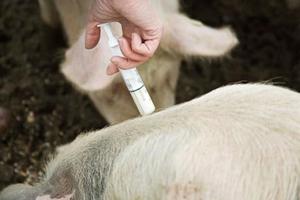Drug resistanceCalifornia lawmakers propose restricting use of antibiotics in livestock
The growth of antibiotic-resistant bacteria in humans has been attributed to the increasing use of antibiotics in livestock. The Centers for Disease Control and Prevention(CDC) estimates that antibiotic-resistant bacteria infect more than two million Americans a year,killing at least 23,000 of them. California legislators are proposing new laws to restrict the use of antibiotics in livestock.

Overuse of antiobotics a major concern // Source: razasporcinas.com
The growth of antibiotic-resistant bacteria in humans has been attributed to the increasing use of antibiotics in livestock. The Centers for Disease Control and Prevention (CDC) estimates that antibiotic-resistant bacteria infect more than two million Americans a year,killing at least 23,000 of them.
“Any time you use an antibiotic, either in an animal or in a human, you are going to put pressure on those bacteria and you are going to create a resistance,” said Dr. Tom Chiller, a medical epidemiologist for the CDC. “We know resistance is occurring across the food chain, really from farm to fork, and we know humans can become sick from those bacteria.”
The San Luis Obispo Tribune reports that California legislators are proposing new laws to restrict the use of antibiotics used on livestock. Senator Jerry Hill (D-San Mateo) and Assemblyman Kevin Mullin (D-South San Francisco) have both introduced bills asserting that the overuse of livestock antibiotics has led to the growth and spread of drug-resistant bacteria. “There’s clearly a public health concern with the overuse of antibiotics,” Mullin said, and “we need to take a bold step now.”
Doctors agree. “Any time you use an antibiotic, either in an animal or in a human, you are going to put pressure on those bacteria and you are going to create a resistance,” Dr. Tom Chiller, a medical epidemiologist for the federal Centers for Disease Control and Prevention, told the Tribune. “We know resistance is occurring across the food chain, really from farm to fork, and we know humans can become sick from those bacteria.”
The Tribune notes that antibiotics used by food producers can be grouped into three categories: antibiotics used to treat existing health issues; antibiotics used to guard against outbreaks; and antibiotics used to help animals increase size or mass more quickly or with less food. California’s $2.8 billion cattle industry insists that food producers need clear access to antibiotics to operate effectively.
Studies showing the link between the growing use of antibiotics in livestock and the proliferation of drug-resistant bacteria began to appear in the 1970s, some twenty years after the FDA had approved the use of antibiotics in food production. “Antibiotics are rampant in our food supply,” said Emelie Peine, a professor at the University of Puget Sound who focuses on global food issues. “If you’re giving them to animals every day it’s creating a huge health problem.”
The Food and Drug Administration (FDA) last December released voluntary guidelines which suggest that pharmaceutical companies change their drug labels, effectively discouraging farmers from using antibiotics to promote growth. Hill’s bill would make the FDA guidelines mandatory.
“I think the FDA did not go far enough in their voluntary requirements,” Hill said. “You make them voluntary, there’s not a real incentive to focus on curtailing the use of antibiotics.”
Assemblyman Mullin’s bill would ban weigh-gain antibiotics and restrict access to preventive antibiotics. Mullin’s bill, which more stringent than Hill’s, would limit the use of, antibiotics to cases in which there is a documented risk of a sick animal infecting other animals.
